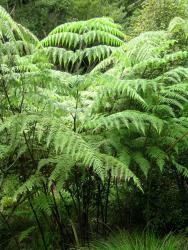Terrestrial ferns. Rhizomes long-creeping, bearing red-brown or pale brown multicellular hairs. Fronds monomorphic, usually determinate but rarely indeterminate (not NZ). Stipes hairy, smooth or rarely spiny (not NZ). Laminae 2–5-pinnate, herbaceous or coriaceous, bearing glandular and/or non-glandular hairs, adaxial sulci of rachis and primary costae not confluent; primary pinnae stalked, arising from rachis at acute angle, lacking basal pinnule-like stipules. Veins free, terminating at convex margin. Sori round or elliptic, superficial, submarginal; paraphyses present or absent. Indusia either absent, or formed from reflexed lamina flaps that vary from membranous and sharply reflexed to green and partially reflexed, opening inwards; inner indusium absent. Spores monolete, usually echinate and sometimes more or less reticulate.
Species of Hypolepis form a clearly defined genus distinct from the other genera in Dennstaedtiaceae on morphological (Brownsey 1998) and molecular grounds (Schuettpelz & Pryer 2007; Perrie et al. 2015). The genus has been revised in Australia (Brownsey & Chinnock 1984; Brownsey 1998), New Zealand (Brownsey & Chinnock 1984) and Malesia and the Pacific (Brownsey 1987), whilst the H. rugosula complex has been analysed worldwide by Schwartsburd & Prado (2014). The latter authors recognised 15 distinct geographic subspecies within H. rugosula, including the taxa that we recognise here as H. amaurorhachis, H. lactea and H. rufobarbata. In our opinion there is ample morphological evidence for recognising these three taxa as species in New Zealand, as well as a ploidy difference between them and H. rugosula in Australia.
| 1 | Sori protected by well-developed, reflexed, partially membranous, lamina flaps; stipes 2–15 mm diameter | dicksonioides |
| Sori unprotected, or protected only by slightly reflexed, green, lamina flaps; stipes 1–6 mm diameter | 2 | |
| 2 | Abaxial surface of lamina and rachis bearing only non-glandular hairs | 3 |
| Abaxial surface of lamina and rachis bearing at least some glandular hairs as well as acicular hairs | 4 | |
| 3 | Laminae up to 770 mm long and 400 mm wide; ultimate lamina segments less than 1 mm wide; paraphyses absent from sori | millefolium |
| Laminae up to 1200 mm long and 1200 mm wide; ultimate lamina segments more than 1 mm wide; paraphyses sometimes present in sori | ambigua | |
| 4 | Lamina margins bearing abundant red-brown (or occasionally colourless) acicular hairs; stipe and rachis purple-brown | rufobarbata |
| Lamina margins bearing colourless glandular or acicular hairs; stipe and rachis pale brown, red-brown or purple-brown | 5 | |
| 5 | Glandular hairs on laminae 0.1–0.3 mm long; stipe and rachis red-brown or purple-brown for at least ¾ their length; plants of North Island and northern South Island | lactea |
| Glandular hairs on laminae 0.3–1.0 mm long; stipe and rachis red-brown for c. ½ their length; plants of southern South Island and subantarctic islands | amaurorhachis |
In New Zealand, species of Hypolepis can be recognised by their creeping rhizomes, highly divided laminae bearing glandular or non-glandular hairs, and more or less round submarginal sori that are either unprotected, or protected by reflexed lamina flaps that open inwards.
A genus of perhaps 80 species (PPG 1 2016) in tropical and temperate regions of Central and South America, southern Africa, India, China, Japan, South-East Asia, Australasia and the Pacific (Brownsey 1998; Yan et al. 2013). There are about 50 species in the Americas (Schwartsburd 2018), three in Africa (Roux 2009), eight in China (Yan et al. 2013), 14 in Malesia and the Pacific (Brownsey 1987), and seven in Australia (Brownsey & Chinnock 1987). Six species in New Zealand; four endemic.
| Category | Number |
|---|---|
| Indigenous (Endemic) | 4 |
| Indigenous (Non-endemic) | 2 |
| Total | 6 |
The base chromosome number in Hypolepis is either x = 26 or x = 52. However, there are also reports of n = 28, 29, 39 and 98, suggesting aneuploidy within the genus (Brownsey 1983).




